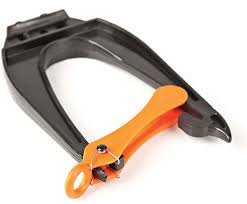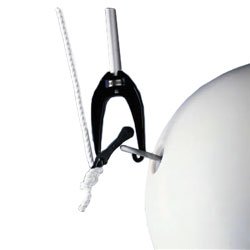Most people I have seen (myself included) most often use one line when on a mooring ball. The line runs from one bow cleat to the ball, through the "ring" and then back to the opposite bow cleat. When leaving, release one end, and pull the line quickly back aboard using the "leg" that is still cleated.
I have tried using 2 lines, (one each side) cleat to ball and back to same cleat and using only one line attaching to the ball ring with a carabiner. The carabiner was a pain. I did not find any real advantage to the "one line each side" set up.
If I expect big wind, I may put on a second line following the same path as the first (opposite to opposite) as a "backup".
The one line (opposite to opposite) has worked well for years with no problems or obvious sign of any chafe on the line.
Picking up the ball can be a challenge, and I have witnessed many people struggling with it over the years.
With our Nordic Tug 37, we either catch the ball (ring) at the pilothouse door (midship) or at the swim grid using a boat hook. We have used an attachment called a "Happy Hooker" that can work very well, but if the ring wants to "lay over" on the ball, the Hooker sometimes is not easy to use.
If you catch the ball at the stern swim grid, to make it easy have a long line led from a bow cleat all the way aft running outside of all stanchions. I tie 2 lines together to do this. The pilot drives the boat slowly past the buoy and brings it alongside at the stern, stopping the boat. Catch the ring using the boat hook. Pass the end of the line through the ring, which is easy at the water level. The line would already have a small loop tied in that end. Now clip a smaller, lighter (pre-deployed) line to the mooring line loop. This line was running down the side deck to the pilothouse door where the pilot can now retrieve the mooring line. The boat is in neutral and will drift slowly (or sometimes a bit more quickly) back bringing the mooring up to the bow. Untie the second line (used to extend the mooring line) and bring the mooring line around the anchor and cleat it off.
Alternatively, catch the ring midship (for us we are only about 3-4 feet off the water), pull up the ring, and have your partner run the line through the ring. Drift back and walk the buoy forward and cleat.
Depending on your boat's setup, one of these methods will be easier than the other. For us both work, but midship is less fuss. However, we have found the odd ring that does not want to be pulled up, so the stern works better for those.


